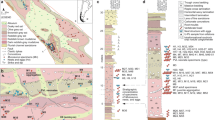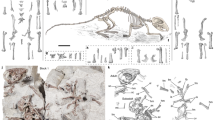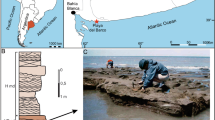Abstract
One of the greatest mysteries associated with dinosaurs is the rarity of juveniles. With the notable exception of the Djadochta and Iren Dabasu Formations of Mongolia and the Two Medicine Formation of Montana, skeletal elements of very young dinosaurs are exceedingly uncommon1–3, leaving a gap in the understanding of dinosaur social structures1,3,4. The most popular explanation, based chiefly on negative evidence, is that the eggs and young were ‘kept’ in the uplands where they were rarely covered by sediments and as a result were destroyed by erosion2. The discovery of fifteen 1-m long hadrosaurian (‘duck-billed’) skeletons together in a nest-like structure offers the first tangible evidence of the social behaviour of at least one group of dinosaurs. They were discovered by Marion Brandvold in terrestrial sediments of the Two Medicine Formation (Upper Cretaceous) near Choteau, Teton County, Montana.
This is a preview of subscription content, access via your institution
Access options
Subscribe to this journal
Receive 51 print issues and online access
$199.00 per year
only $3.90 per issue
Buy this article
- Purchase on Springer Link
- Instant access to full article PDF
Prices may be subject to local taxes which are calculated during checkout
Similar content being viewed by others
References
Jepsen, G. L. Am. Sci. 52, 227–247 (1964).
Sternberg, C. M. Bull. Can. Dept. No. Affirs. Nat. Res. 136, 120–122 (1956).
Richmond, N. D. J. Paleont. 39, 503–505 (1965).
Colbert, E. H. The Year of the Dinosaur, 1–171 (Scribner, New York 1977).
Kaye, J. M. & Russell, D. A. J. Paleont. 47, 1, 91–93 (1973).
Langston, W. Jr Fieldiana Geol. Mem. 3, 6, 313–360 (1960).
Gilmore, C. W. Proc. U.S. nat. Mus. 61, 3, 1–4 (1922).
Colbert, E. H. Evolution 2, 145–163 (1948).
Gilmore, C. W. Exploration and Field Work for the Smithsonian Institution for 1929, 7–12 (1929).
Dodson, P. Palaeogeog. Palaeoclim. Palaeoecol. 10, 21–74 (1971).
Dodson, P. Syst. Zool. 24, 37–54 (1975).
Author information
Authors and Affiliations
Rights and permissions
About this article
Cite this article
Horner, J., Makela, R. Nest of juveniles provides evidence of family structure among dinosaurs. Nature 282, 296–298 (1979). https://doi.org/10.1038/282296a0
Received:
Accepted:
Issue Date:
DOI: https://doi.org/10.1038/282296a0
This article is cited by
-
Hadrosauroid eggs and embryos from the Upper Cretaceous (Maastrichtian) of Jiangxi Province, China
BMC Ecology and Evolution (2022)
-
Calibrating the zenith of dinosaur diversity in the Campanian of the Western Interior Basin by CA-ID-TIMS U–Pb geochronology
Scientific Reports (2022)
-
First ovum-in-ovo pathological titanosaurid egg throws light on the reproductive biology of sauropod dinosaurs
Scientific Reports (2022)
-
The first occurrence of an avian-style respiratory infection in a non-avian dinosaur
Scientific Reports (2022)
-
Competition structured a Late Cretaceous megaherbivorous dinosaur assemblage
Scientific Reports (2019)
Comments
By submitting a comment you agree to abide by our Terms and Community Guidelines. If you find something abusive or that does not comply with our terms or guidelines please flag it as inappropriate.



